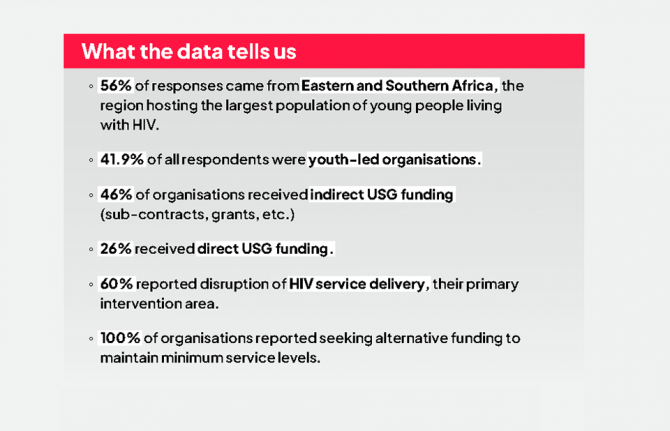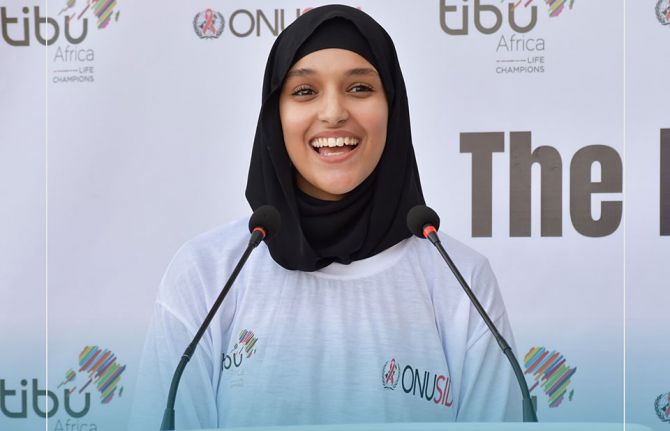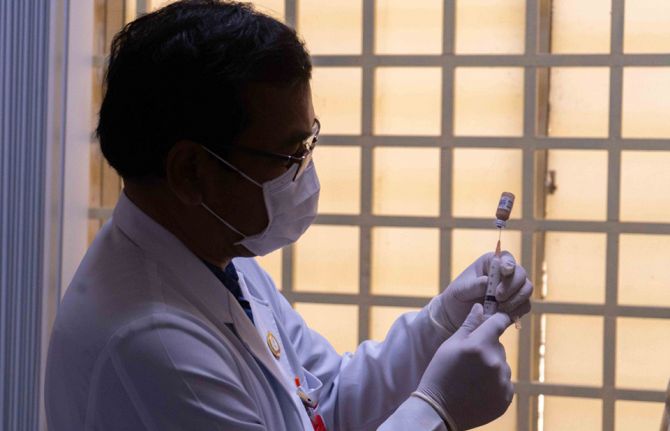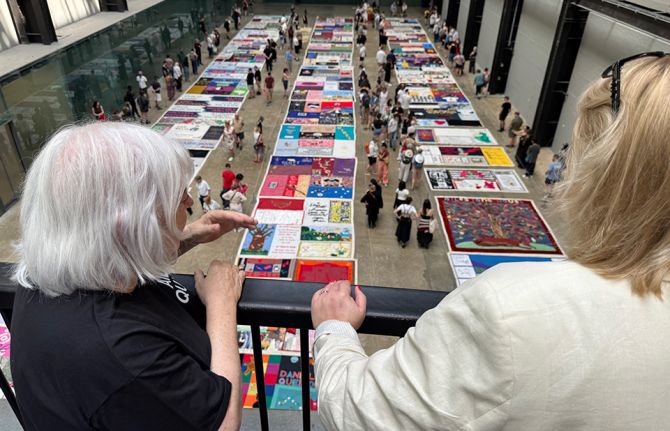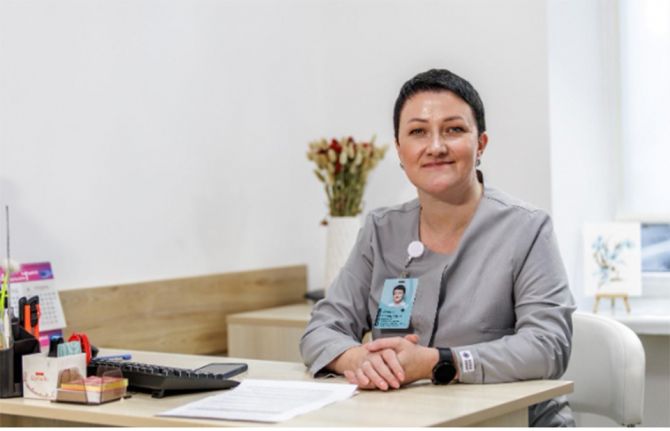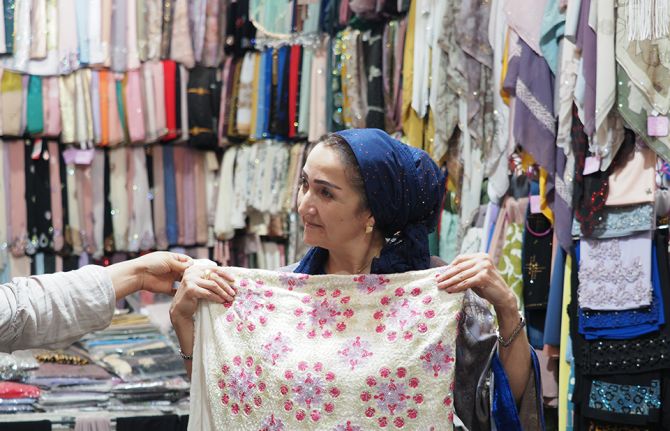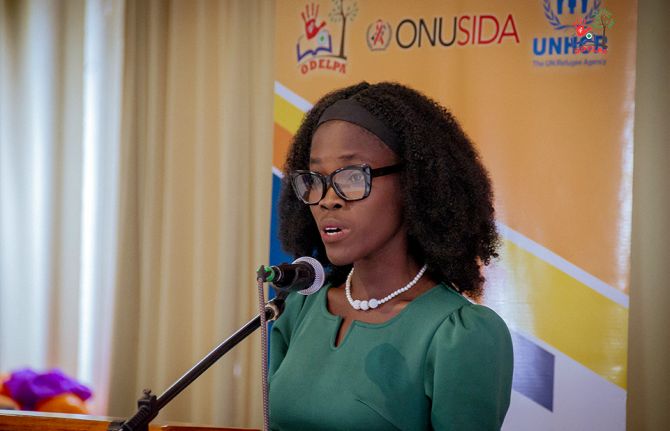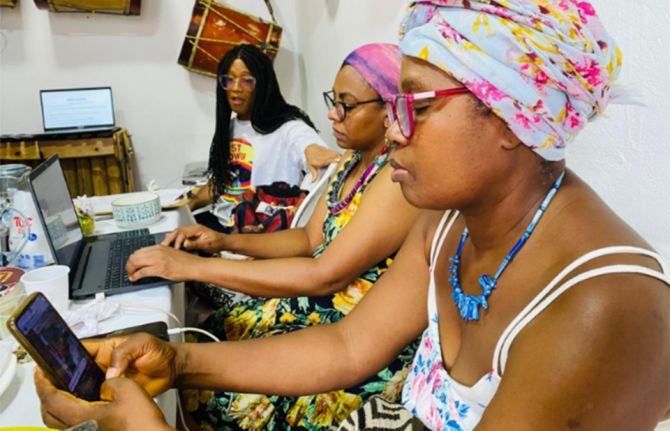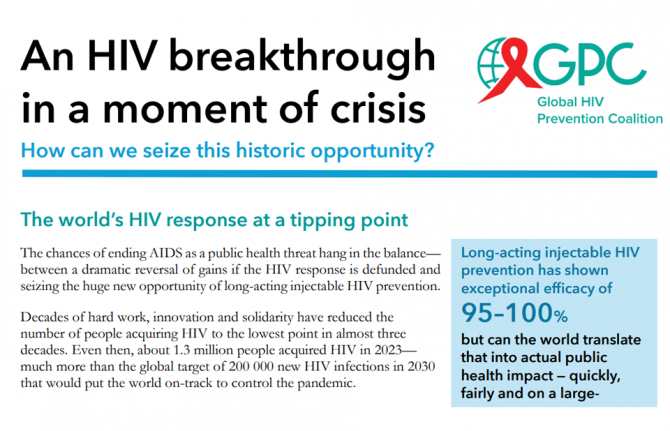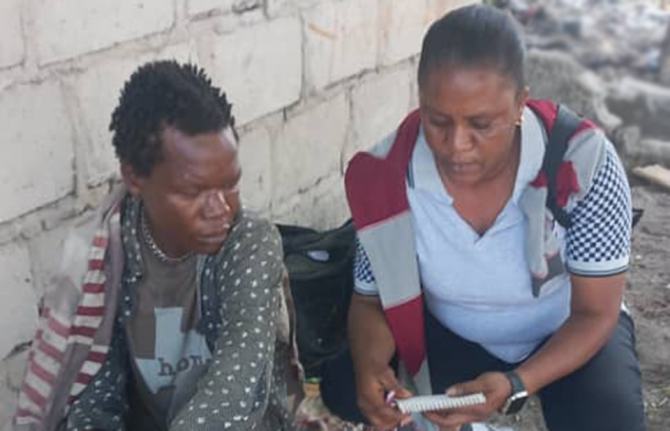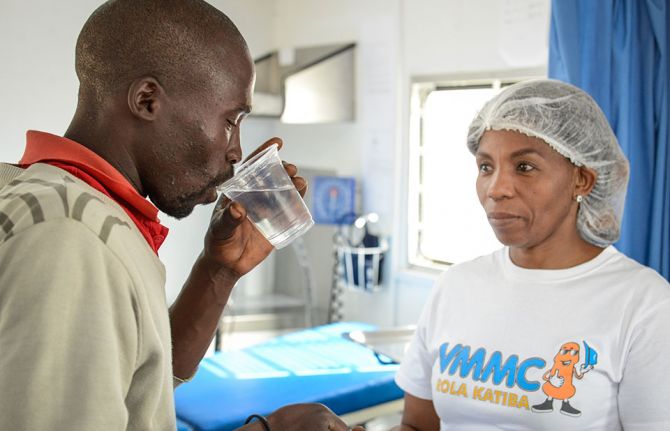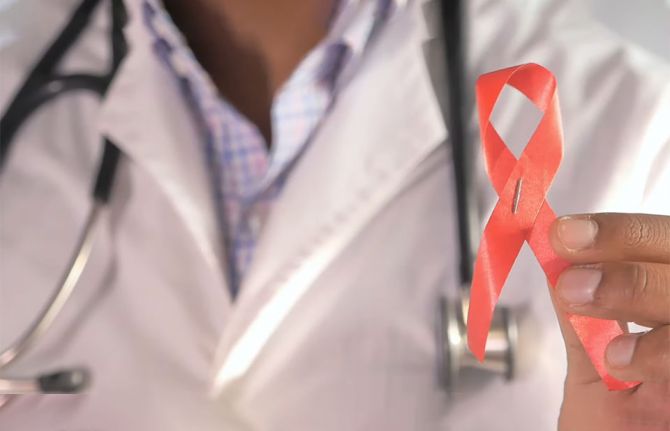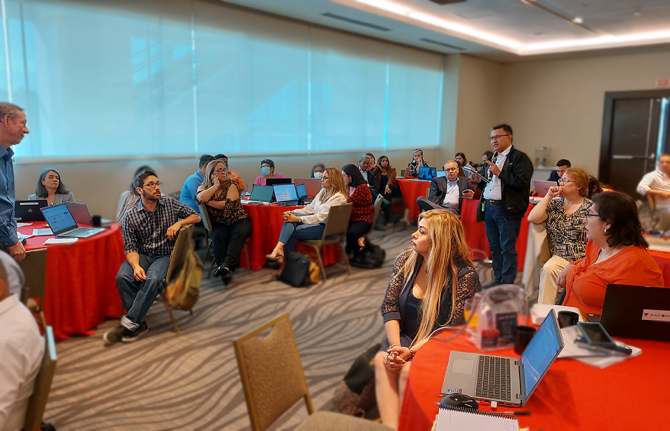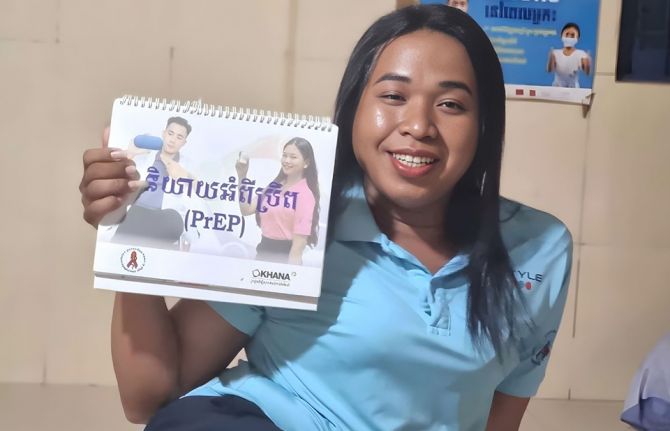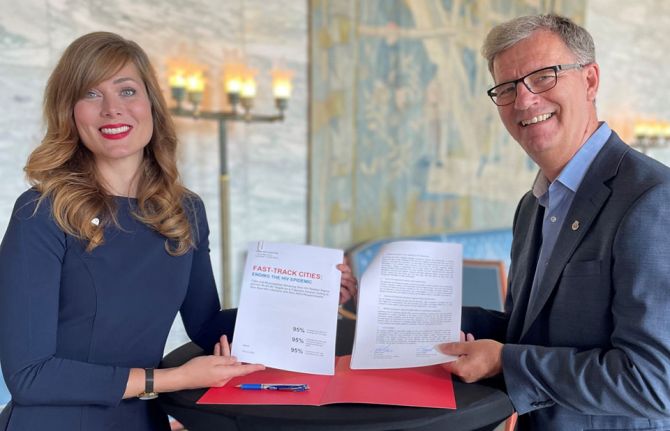
Feature Story
New grants available for young leaders
26 March 2010
26 March 2010 26 March 2010
Young leaders have innovative ideas about how to reach their peers.
Following UNAIDS calls for putting young people’s leadership at the centre of national HIV responses, a new small grants programme for youth-led organizations and projects, the HIV Young Leaders Fund, announced their request for proposals. The mission of the Fund is to enable new leadership in the AIDS response among young people who are most-at-risk and vulnerable to HIV and young people living with HIV.
“Peer-based programming is highly effective yet chronically underfunded and youth-led programs often lack support for core resources,” said Liping Mian, World AIDS Campaign Youth Campaign Coordinator and HIV Young Leaders Fund Interim Steering Committee member.
Globally, young people aged 15-24 account for 40% of all new infections and in 2008; at least 2 out of every 5 people newly infected with HIV were 15-24 years old.
As noted in its Outcome Framework: Joint Action for Results (2009-2011), UNAIDS has made empowering young people one of its priority areas. The goal in this priority area is to reduce the number of new HIV infections among young people (aged 10 to 24 years) by providing comprehensive sexual and reproductive knowledge, skills, services and commodities in a safe and enabling environment, tailored to the specific country and epidemic context.
Peer-based programming is highly effective yet chronically underfunded and youth-led programmes often lack support for core resources.
Liping Mian, World AIDS Campaign Youth Campaign Coordinator and HIV Young Leaders Fund Interim Steering Committee member
Depending on the context, most-at-risk and vulnerable young people include young men who have sex with men, young transgenders, young sex workers, young injecting drug users, young women and young people living with HIV.
The Fund, administered by the Tides Foundation, will support youth led organizations and youth-led projects working on peer-based services, community mobilization, and advocacy. Organizations from all countries can apply for grants whose amount range goes from $1,000 to $30,000. The deadline for grant applications is May 1, 2010. Grant-making decisions will be made by regional community review panels composed of young leaders.
The new small grants programme is one of the recommendations from the 2009 aids2031 Young Leaders Summit that took place in Oslo in June 23 – 25. During the three day Summit, more than 30 young leaders from around the world worked together to identify pressing stigma and discrimination issues for young people and identify ways to leverage current strategies and collaborations.
To request grant materials in Arabic, English, French, Russian or Spanish, please e-mail HIVYoungLeadersFund@gmail.com
An Interim Steering Committee serves as the governing body for the HIV Young Leaders Fund in 2010. The following organizations are on this governing body: Global Network of Sex Work Projects, Global Youth Coalition on HIV/AIDS, GNP+’s Interim Reference Group on Young People Living with HIV, International Treatment Preparedness Coalition, Jamaica Youth Advocacy Network, World AIDS Campaign, Youth Coalition for Sexual and Reproductive Rights, Y-PEER, Young Positives, and Youth R.I.S.E.
New grants available for young leaders
Related
 “Who will protect our young people?”
“Who will protect our young people?”

02 June 2025

Feature Story
International consultation on “Positive Health, Dignity and Prevention” in Casablanca
26 March 2010
26 March 2010 26 March 2010
Nicolas Ritter founder of Prevention, Information and Fight against AIDS (PILS) speaking at the technical consultation on positive health, dignity and prevention. Casablanca, Morocco on 28 March 2010.
Nicolas Ritter is a pioneer in the drive to ensure that people living with HIV are at the centre of the AIDS response. He was the first person from Mauritius to announce publicly that he was HIV positive. “It seemed logical that people with HIV should be part of the response, but it took a long time for others with HIV to come forward, because of their fear of stigmatization,” said Ritter.
In 1996, Ritter founded Prevention, Information and Fight against AIDS (PILS) in Mauritius with the mission of campaigning for improving the quality of life for people living with HIV and involving them in all aspects of prevention. Fourteen years later, PILS now has 13 “positive ambassadors” who speak in schools, businesses and to the media about HIV prevention.
As antiretroviral treatment has given millions of people a new lease on life, HIV prevention programmes have begun to refocus their attention on people who know their HIV positive status to ensure people living with HIV are at the forefront of developing and implementing HIV policies. To support this, the Global Network of People living with HIV (GNP+) and UNAIDS held a technical consultation in Casablanca, Morocco on 28 March.
Positive Health, Dignity and Prevention
Around 30 international participants representing people living with HIV, civil society, government agencies, UNAIDS Cosponsors, international donors and development agencies took part in the discussions, which come almost a year after a key meeting in Tunisia. During that consultation, participants moved away from the expression “positive prevention,” finding that it stigmatized people living with HIV. To shift the unfair burden of responsibility for HIV transmission away from HIV positive people, they coined the term “Positive Health, Dignity and Prevention”.

Participants highlighted the importance of making positive health, dignity and prevention undeniable elements of combination prevention. Casablanca, Morocco on 28 March 2010.
During the consultation in Casablanca, stakeholders shared best practices, identified challenges, common goals and looked at opportunities in programming, politics and research. “This discussion has been vital in moving the debate forward,” said Nicolas Ritter, “we looked at ways to turn the concept of “Positive Health, Dignity and Prevention” into concrete action.”
Participants highlighted the importance of making positive health, dignity and prevention undeniable elements of combination prevention. They stressed a human rights approach based on legal protection and a policy environment free of discrimination and examined ways to address social vulnerabilities such as poverty, gender-based violence, xenophobia and homophobia. “We looked at the major roadblocks to dramatically increasing the participation of people living with HIV in prevention programmes,” said Helene Badini UNAIDS Regional Adviser, Social Mobilization.
5th Francophone Conference on HIV
The international consultation was held in Casablanca as part of the 5th Francophone Conference on HIV which is taking place from 28 to 31 March. The event brings together over 1,500 health professionals, researchers, government officials, civil society and leading francophone actors of the HIV response. The conference is chaired by Profession Francoise Barré-Sinoussi, Nobel Laureate for Medicine 2008. UNAIDS is collaborating in the event for the first time and in addition to the consultation on “Positive Health, Dignity and Prevention” it is also helping to organize a symposium on HIV and human rights on Tuesday with the United Nations Development Programme. UNAIDS Executive Director Mr Michel Sidibé will be speaking at Wednesday’s closing ceremony.
International consultation on “Positive Health, D
Realted information:
Feature stories:
International Technical Consultation on ‘Positive Prevention’ (27 April 2009)
External links:
Global Network of People living with HIV (GNP+)
5th Francophone Conference on HIV
Publications:
Positive Health,Dignity and Prevention (pdf, 1Mb.)
Advancing the Sexual and Reproductive Health and Human Rights of People Living with HIV (pdf, 1.93 Mb.)

Feature Story
Spotlight on human rights at the 5th Francophone Conference on AIDS
26 March 2010
26 March 2010 26 March 2010
This year human rights and law will be in the spotlight at the 5th Francophone Conference on AIDS held in Casablanca, Morocco from 28 to 31 March 2010. Credit: UNAIDS/P.Virot
This year human rights and law will be in the spotlight at the 5th Francophone Conference on AIDS held in Casablanca, Morocco from 28 to 31 March 2010. The conference is taking place against a backdrop of continuing discrimination and human rights infringement of people living with HIV across the world. There are reports of harassment, prosecution of and violence against people living with HIV in several francophone countries.
However, leaders and policy makers are increasingly recognising the importance of addressing the legal and policy environment as a fundamental component of national AIDS responses. This is particularly true for populations such as men who have sex with men, prisoners, sex workers and people who use drugs whose marginalisation hinder their access to HIV-related services.
Countries are taking action. Guinea, for example, recently amended its HIV law of 2005 to remove any restriction to access HIV-related services for children and to ensure access to HIV-related prevention, treatment, care and support for populations including men who have sex with men. Similar processes are ongoing in Togo, Benin and Sierra Leone.
In East Africa, UNAIDS is currently supporting the development of a regional Bill on HIV which would protect people against HIV-related stigma and discrimination and other human rights abuses in the context of the HIV epidemic.
In order to help support the current initiatives aimed at ensuring access to HIV-related services as well as access to justice in the context of the HIV epidemic in francophone countries, UNAIDS, UNDP, the African Council of AIDS Service Orgnizations (AfriCASO), the Association Marocaine de Solidarité et Développment (AMSED), International Development Law Organization (IDLO), and the International HIV/AIDS Alliance are organising a preconference meeting on 28 of March which will focus on strengthening and expanding HIV-related legal services in the region.
The meeting will bring together lawyers, advocates, representatives of people living with HIV and representatives of key populations at higher risk to share their experiences and discuss ways to increasing HIV-related support for those who need it most.
“Analyses in many countries reveal the existence of punitive laws and law enforcement that drive people away from HIV-related services,” said Susan Timberlake, UNAIDS Senior Human Rights and Law Adviser. “It is critical to support law reform as well as access to justice through legal services to create a legal environment that will support people to access HIV-related services. To respond effectively to HIV, we need to protect, not punish, with the law.”
UNAIDS believes that a protective legal environment is critical for an effective response to HIV. In 2009 UNAIDS strengthened its focus on the removal of punitive laws, policies, practices, stigma and discrimination that block effective responses to AIDS by making it one of ten key priority areas outlined in the UNAIDS Outcome Framework 2009-2011 (Joint action for results: UNAIDS outcome framework, 2009 - 2011).
On Tuesday 30 March UNAIDS together with UNDP will be holding a symposium event on the legal environment to the AIDS response in Francophone countries during the Conference themed “HIV and the Law: addressing the barriers and realising Universal Access.”
Spotlight on human rights at the 5th Francophone
External links:
5th Francophone Conference on AIDS
Publications:
Joint action for results: UNAIDS outcome framework, 2009 - 2011 (pdf, 915 Kb)
HIV-related Stigma, Discrimination and Human Rights Violations Case studies of successful programmes (pdf, 1 Mb.)
International Guidelines on HIV/AIDS and Human Rights (pdf, 932 Kb.)
The UNAIDS Guide to the United Nations Human Rights Machinery (pdf, 3.53 Mb.)

Feature Story
Dr Julio Montaner, President of the International AIDS Society, visits UNAIDS
25 March 2010
25 March 2010 25 March 2010
Dr Julio Montaner, the President of the International AIDS Society, speaks at UNAIDS Headquarters in Geneva. 24 March 2010.
Credit: UNAIDS
Dr Julio Montaner, the President of the International AIDS Society (IAS), visited the UNAIDS Secretariat in Geneva on 24 March. At the headquarters he met with UNAIDS staff and discussed various topics including the concept of ‘treatment as prevention’’ which has come from his long standing work in Vancouver, Canada.
In an interview with UNAIDS, Dr Montaner, gave an overview of some of the key emerging issues at the upcoming XIII International AIDS Conference, or AIDS 2010, organised by the IAS. The conference will be held in Vienna from 18 to 23 July.
Vienna, according to Dr Montaner, was chosen as the location for AIDS 2010 as it presents an opportunity to put the spotlight on HIV epidemics in Eastern Europe. HIV transmission occurs mainly among the injecting drug user population and their partners in the region, and Eastern Europe and Central Asia is the only region in the world where the HIV epidemic remains on the rise.
In the Eastern European context, addressing the injecting drug use HIV epidemic is critical. If we neglect the evidence-based prevention programmes that we know work for this community we will not have a chance of containing the epidemic.
Dr Julio Montaner
“In the Eastern European context, addressing the injecting drug use HIV epidemic is critical. If we neglect the evidence-based prevention programmes that we know work for this community we will not have a chance of containing the epidemic,” Dr Montaner said and continued “as the IAS, we want to make it clear that we need drastic measures to deal with the injecting drug use HIV epidemic in Eastern European context as well as the rest of the world.”

Dr Montaner gave an overview of some of the key emerging issues at the upcoming AIDS 2010 conference organised by the IAS. 24 March 2010.
Credit: UNAIDS
Dr Montaner also said that AIDS 2010 will provide a great platform for merging the universal access and Millennium Development Goals movements. “This is a unique opportunity to rally behind universal access to contribute towards a renewed and re-energized commitment to deliver on the Millennium Development Goals.”
Dr Montaner is Professor, Chair in AIDS Research, and Head of the Division of AIDS at the Faculty of Medicine of the University of British Columbia; he is also Director of the British Columbia Centre for Excellence in HIV/AIDS at St. Paul's Hospital-Providence Health Care. He has focused his research in the development of antiretroviral therapies and management strategies. In the mid 90s, he played a key role in establishing the efficacy of the antiretroviral therapy (HAART). This was one of the pivotal contributions which emerged from the Vancouver 1996 International AIDS Conference.
Dr Julio Montaner, President of the International
Press centre:
Antiretroviral therapy and sexual transmission of HIV
Feature stories:
Antiretroviral treatment for prevention (06 Nov 2009)
External links:
International AIDS Society
AIDS 2010
Publications:
Intensifying HIV Prevention: UNAIDS Policy Position Paper (2005) (pdf, 3.80 Mb.)
Practical Guidelines for Intensifying HIV Prevention (2007) (pdf, 1.67 Mb.)
Related

Feature Story
Guyana launches national HIV prevention principles, standards and guidelines
24 March 2010
24 March 2010 24 March 2010
Hon. Dr. Leslie Ramsammy, Minister of Health of Guyana launching the national HIV prevention, principles, standards and guidelines. 24 March 2010.
On Wednesday 24th March 2010, Guyana unveiled the country’s new national principles, standards and guidelines for the prevention of HIV as part of its efforts to achieving universal access to HIV prevention, treatment, care and support.
“By 2020 Guyana must be well on the road towards elimination of HIV as a major public health problem,” said Dr Leslie Ramsammy, Guyana’s Minister of Health.
The principles, standards and guidelines are the result of two years of work under the leadership of the Ministry of Health’s National AIDS Programme, in close collaboration with UNAIDS. Guyana’s HIV prevention quality standards are fully in line with the UNAIDS Executive Director’s call for a global “prevention revolution” to reduce the number of new HIV infections.
“Prevention is a key priority. We need to construct a compelling prevention narrative. One built upon equality and human rights. One that recognizes the importance of responses that are strategically tailored to local epidemics, that include biomedical, behavioural and structural approaches, and that meaningfully involves beneficiaries,” said UNAIDS Executive Director Michel Sidibé.
According to UNAIDS, the national HIV prevention principles, standards and guidelines represent an important step forward for intensifying HIV prevention activities in Guyana, and should serve as a model for other countries in the region. The guidelines feature a scorecard for rating the quality of prevention programmes being implemented.
Guyana launches national HIV prevention principle
Feature stories:
‘Health Research in the Americas V’ focuses on HIV prevention (11 May 2009)
Barber Shops and Beauty Salons promote HIV education in Guyana (26 March 2009)
Guyana launches national ‘faith-and-HIV’ coalition (16 December 2008)
External links:
National AIDS Programme of Guyana
Publications:
Guyana National HIV Prevention Principles, Standards and Guidelines
Related

Feature Story
Religious summit engages religious leaders in the HIV response
23 March 2010
23 March 2010 23 March 2010
Rev. Gunnar Stålsett, Bishop Emeritus of the Church of Norway (right) with His Holiness Abune Paulos signing the personal commitment to action at the Summit of High Level Religious Leaders on the Response to HIV. 22-23 March, The Netherlands.
Credit: UNAIDS
A Summit of High Level Religious Leaders on the Response to HIV took place in The Netherlands from 22 to 23 March. The meeting explored opportunities for religious leaders to promote universal access to HIV prevention, treatment, care and support in their communities and speak out against stigma and discrimination affecting people living with HIV. It brought together some 40 Baha’í, Buddhist, Christian, Hindu, Jewish, Muslim and Sikh leaders together with the Executive Directors of the Joint United Nations Programme on HIV/AIDS (UNAIDS) and the United Nations Population Fund (UNFPA), the AIDS Ambassadors of The Netherlands and Sweden, leaders and representatives of networks of people living with HIV and other organizations active in the response to HIV.
Speaking at the opening ceremony, UNAIDS Executive Director Michel Sidibé said, "As I travel the world, I see increasing evidence of social injustice. Growing economic disparities, inequality and social injustice stalk the earth. The greatest impact is felt by the poorest segments of society, on women and girls and on the marginalized. Social injustice only serves to increase the vulnerability of the vulnerable and push them farther out of reach of HIV services. I sincerely hope that this meeting will produce a call for action to make these services available and virtually eliminate mother to child transmission of HIV. Nothing would be more noble than a world with no more babies born with HIV."
I sincerely hope that this meeting will produce a call for action to make these services available and virtually eliminate mother to child transmission of HIV. Nothing would be more noble than a world with no more babies born with HIV.
UNAIDS Executive Director Michel Sidibé
During the Summit, participants addressed the realities of how stigma and discrimination are perpetuated both in religious communities and society at large. They identified best practices to strengthen the voice and action of religious leaders and bring about collaboration among different faiths and with other sectors involved in the response to HIV.
“The leaders gathered at this summit have the ability to inspire and empower change – within their own communities, across countries, and throughout wider communities,” said Rev. Dr. Richard Fee, Chair of the Board of Directors of the Ecumenical Advocacy Alliance and General Secretary, Life and Mission Agency, Presbyterian Church in Canada. “In the midst of what appears to be ‘AIDS fatigue” they have the potential to galvanize efforts against a disease that continues to spread, driven by silence, fear, violence and injustice.”
Since the beginning of the HIV epidemic, religious communities, mosques, temples, churches, hospitals and clinics have reached out to provide support to those living with and affected by HIV. Strengthening their leadership can greatly influence the lives of many people, and leaders speaking out responsibly about AIDS can make a powerful impact at both community and international level.
"Participants affirmed in their concluding statement the "renewed sense of urgency" to prioritize and strengthen the response to HIV. Such response includes "holistic prevention" in addition to reaching universal access to treatment, care and support. The statement called for the "Universal respect for the human rights of all people living with and affected by and at risk of HIV infection" and the "respect for the dignity of every human being". Leaders also called for "a massive social mobilization" to support services for women to eliminate the transmission of HIV from mother to child.
In addition, religious leaders drafted and personally signed a pledge to commit themselves to strengthened efforts to respond to HIV. The pledge includes "deepening meaningful engagement with people living with HIV" and "acting decisively to protect human rights within my faith community; through collaboration among other religious leaders of different faiths; and by influencing local, national, regional and global decision-making processes on HIV."
Dr Thoraya Ahmed Obaid, Executive Director of UNFPA, in her closing remarks said, "Our work together proves that interventions can be successful and sustainable if change is inclusive, if it emerges from within the faith and cultures of the people themselves, if people of all age groups living with (or without) HIV are secure in their sense of belonging and are fully engaged, and all partners are equally valued and respected."
The co-chairs of the event were His Holiness Sri Sri Ravi Shankar, Founder of the Art of Living Foundation; Rabbi David Rosen, Director of Interreligious Affairs of the American Jewish Committee; Ms. Nyaradzayi Gumbonzvanda, General Secretary of the World YWCA; and the Right Rev. Gunnar Stålsett, Bishop Emeritus of the Church of Norway.
The Summit was organized by the Ecumenical Advocacy Alliance and Cordaid, with support from the Dutch Ministry of Foreign Affairs, UNAIDS, International Network of Religious Leaders Living with or Personally Affected by HIV or AIDS (INERELA+), the World AIDS Campaign and the European Council of Religious Leaders (Religions for Peace).
Religious summit engages religious leaders in the
Press centre:
Closing statement by religious leaders
Speeches:
Speech by UNAIDS Executive Director to Summit of High Level Religious Leaders
Feature stories:
UNAIDS launches framework for partnership with religious organizations (07 December 2009)
External links:
Ecumenical Advocacy Alliance
Cordaid
Publications:
Engaging Faith-Based Organizations for the MDGs: the UN Experience (pdf, 393 Kb.)
Scaling up effective partnerships: a guide to working with faith-based organizations in the response to AIDS
HIV prevention, care and support across faith-based communities
UNAIDS Reference Group on HIV and Human Rights statement on anti-homosexuality laws and prosecutions (pdf, 61.4 Kb.).

Feature Story
Taking HIV prevention on the road
22 March 2010
22 March 2010 22 March 2010
Courtesy of the World Bank
For many in West Africa, the road network is a vital socio-economic lifeline but it can also be a way for the spread of HIV. An ambitious programme, the World Bank Abidjan-Lagos Transport Corridor (ALCO) project, has seen marked success in helping people living and working along this highway to reduce their vulnerability to HIV. ALCO’s results, opportunities and challenges are analyzed in a recent World Bank report, part of its HIV/AIDS in Africa: Getting Results series.
The report highlights that HIV prevalence in the transport sector is higher than in the general population, and with some 14 million people travelling along the 1,000 kilometre corridor each year, need for an effective intervention was clear.
The ALCO project, set up in 2004 and sustained since 2007 by a grant from the Global Fund, identified some of the circumstances on the road stretching from Cote d’Ivoire to Nigeria conducive to high risk behaviour. For example, many truck drivers and other mobile workers spend large amounts of time away from their families and often have multiple partners. These include sex workers and others living along the highway and around truck stops.
The aim of the project was to provide HIV prevention services to people in these areas such as truck drivers, sex workers, travellers, border communities and military and customs officials.
Project plan
Multiple partners participated in the project, including national and local government and the health and transport sectors. Stakeholders were brought together on a number of levels and often with distinct concerns and priorities. 87 implementing agencies were engaged in total, with the World Bank offering targeted technical support. UNAIDS, according to the report, provided technical and financial support and was crucial in bringing the project to completion.
The programme had three facets. The first one involved HIV prevention and concentrated on behaviour change, increase HIV awareness and condom distribution. In three and a half years, more than 600 condom sales points were set up along the route and nearly nine million condoms distributed.
The second component, care and support, included providing voluntary HIV counselling and testing, community based care, diagnosis of opportunistic and sexually transmitted infections and antiretroviral treatment.
The final aspect involved inter-country coordination, training and policies to maximise the benefits of working across borders on a regional project, and reduce the long waits at border crossings.
Results
Several lessons were learned, such as the importance of the strong participation of HIV-positive people: the West African Network of People Living with HIV/AIDS was a key partner. According to the project’s managers, the integral involvement of PLHIV and the sense of their ownership of the project helped to make it a success. There was also a harmonised, cross-border, evidence-based communications strategy which provided consistent messaging, emphasised community participation and engaging gatekeepers, built communications capacity in both traditional and non-traditional service providers and paid specific attention to gender issues.
By the end of the project’s first phase, some 28,000 people along the corridor had accessed voluntary HIV counselling and testing services and nearly 1,500 border town residents had been trained as key community AIDS information, education and communications activists.
HIV prevention knowledge increased dramatically in the target populations, from 50-68% to 83-88%. Condom use at last encounter increased significantly, and prevalence of other sexually transmitted infections among sex workers fell markedly. Other knock-on effects have included an increased commitment to workplace AIDS programmes in the transport sector.
Challenges
The project has not been without challenges. From programme materials to systems and the forging of new partnerships had to be set up from scratch. Building grassroots capacity was described in the report as difficult and costly. The cross-border nature of the project also required a huge effort in coordination, time and diplomacy, with a need to work in both English and French and an array of local languages.
However, the Corridor project has made a real and measurable difference in HIV-related knowledge and behaviour amongst people living along West Africa’s Abidjan to Lagos transport route. The five year follow-on grant from the Global Fund to Fight AIDS, Tuberculosis and Malaria is making it possible to sustain this success.
According to the report, “Perhaps the most important contributions of the Abidjan- Lagos Corridor Project have been bringing HIV prevention programmes to very hard-to-reach and vulnerable people and establishing a platform for regional integration beyond AIDS and transportation.”
Taking HIV prevention on the road
Cosponsors:
Feature stories:
The route to good living: World Bank guide to HIV prevention in Africa’s transport sector (14 July 2009)
External links:
More on the World Bank’s sub-Saharan Africa Transport Policy Programme (SSATP)
World Bank’s AIDS work in Africa
Publications:
Transporting HIV Prevention across Borders: The HIV/AIDS Project for the Abidjan-Lagos Corridor (pdf, 487.6 Kb.).
The route to good living: An overview of roles and responsibilities for HIV prevention strategies in transport sector projects (pdf, 716.4 Kb.).

Feature Story
WHO report highlights growing numbers of drug-resistant tuberculosis
19 March 2010
19 March 2010 19 March 2010
For the first time, the WHO global report includes an assessment of progress countries are making in the diagnosis and treatment of multidrug-resistant TB.
Up to a quarter of people with tuberculosis in some regions can no longer be treated with standard drug regimens. This is the stark finding of a new World Health Organization report which estimates that 440,000 people had multidrug-resistant TB (MDR-TB) in 2008, a third of whom died.
Multidrug and Extensively Drug-Resistant Tuberculosis (M/XDR-TB): 2010 Global Report on Surveillance and Response presents data from 114 countries. It underlines that almost half of all cases of MDR-TB are estimated to occur in China and India. In Africa an estimated 69,000 cases emerged.
The report also explores the relationship between HIV and MDR-TB and notes that drug resistant TB among people living with HIV has been widely documented in certain settings, such as hospitals. It further states that TB patients co-infected with HIV in three Eastern European countries, Estonia, Latvia, and the Republic of Moldova, were found to be at greater risk of having multidrug-resistant tuberculosis compared to TB patients without HIV infection. Studies in Lithuania, Ukraine and Mozambique show similar results. More research is required to ascertain whether these findings would be replicated worldwide and the report notes that no data have been received from countries with the highest HIV prevalence.
According to UNAIDS, HIV-positive people are especially vulnerable to the impact of TB and MDR-TB. They are at increased risk of contracting the disease and experiencing serious side effects and are more likely to die if infected. HIV and TB are seen as so closely connected that they are often referred to as ‘co-epidemics’. To appropriately respond to both epidemics and avoid more widespread drug resistance, fully integrated TB/HIV services should be priority concern of all TB and HIV programmes.
Preventing people living with HIV dying from tuberculosis is one of the nine priority areas in the UNAIDS Outcome Framework 2009-11.
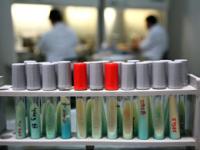
According to the WHO report only an estimated 7% of all MDR-TB patients are diagnosed. Credit: WHO/D.Orr
For the first time, the WHO global report includes an assessment of progress countries are making in the diagnosis and treatment of multidrug-resistant TB. Six countries are the subject of special focus. Bangladesh is one of the few developing nations carrying out continuous surveillance among TB cases which were previously treated in selected areas. China has reported results from its first ever drug resistance survey; Ethiopia was among the first countries to introduce rapid molecular laboratory tests. Nepal and Romania both have successful treatment programmes for MDR-TB and South Africa has introduced policy changes for improving management and care for those living with the disease.
Although there has been notable success in some countries, world-wide progress in controlling multidrug-resistant TB remains slow. According to the WHO report only an estimated 7% of all MDR-TB patients are diagnosed.
Of major concern is the very high cost of treating this form of the disease. The price of drugs alone is 50 to 200 times higher than treating a drug-susceptible TB patient. However, WHO maintains that treatment of MDR-TB has been shown to be cost-effective.
According to the report, there is an urgent need for drug regimens which are shorter than the current two year span, improvements in laboratory facilities and access to rapid diagnosis and treatment. WHO is undertaking a five-year project aimed at strengthening TB laboratories with rapid tests in some 30 countries. It is also working closely with a number of organisations to increase access to treatment so that more lives can be saved.
Note: Multi-drug resistant TB (MDR-TB) is tuberculosis that is resistant to at least Rifampicin and Isoniazid, the two most powerful anti-tuberculosis drugs. Extensively drug- resistant TB (XDR-TB) is MDR-TB that is also resistant to at least two out of the three classes of second line TB medicines.
WHO report highlights growing numbers of drug-res
Cosponsors:
Partners:
Feature stories:
Call for global action on the threat of drug-resistant tuberculosis (03 April 2009)
Call for fully funded Global Fund to fight AIDS, Tuberculosis and Malaria (31 March 2009)
UNAIDS Executive Director meets with TB Programme Managers, TB civil society (26 March 2009)
Need for scale up in integrated TB and HIV screening to address linked epidemics (24 March 2009)
TB deaths rise in people living with HIV (17 March 2008)
MDR-TB more common in people living with HIV (28 February 2008)
Publications:
Multidrug and Extensively Drug-Resistant Tuberculosis (M/XDR-TB): 2010 Global Report on Surveillance and Response (pdf, 850 Kb)

Feature Story
Disproportionate impact of HIV on men who have sex with men in US underlines need for better outreach
18 March 2010
18 March 2010 18 March 2010
New data analysis released on 10 March by the United States Centers for Disease Control and Prevention (CDC) highlights that HIV and syphilis disproportionately impact men who have sex with men in the United States (U.S.).
New data analysis released on 10 March by the United States Centers for Disease Control and Prevention (CDC) highlights that HIV and syphilis disproportionately impact men who have sex with men in the United States (U.S.).
The data, presented at CDC's 2010 National STD Prevention Conference, found that the rate of new HIV diagnoses among men who have sex with men (MSM) in the U.S. is more than 44 times that of other men and more than 40 times that of women.
"While the heavy toll of HIV and syphilis among gay and bisexual men has been long recognized, this analysis shows just how stark the health disparities are between this and other populations," said Kevin Fenton, M.D., Director of CDC's National Center for HIV/AIDS, Viral Hepatitis, STD, and TB Prevention. "It is clear that we will not be able to stop the U.S. HIV epidemic until every affected community, along with health officials nationwide, prioritize the needs of gay and bisexual men with HIV prevention efforts."
According to CDC many aspects contribute to the high rates of HIV and syphilis among gay and bisexual men in this country. Homophobia and stigma can prevent MSM from seeking prevention, HIV testing and counselling, and treatment services. Other causes include limited access to prevention services, unsafe sex practices and complacency about HIV risk due to existence of treatment, particularly among young gay and bisexual men. Also, the risk of HIV transmission through anal sex is much greater than the risk of transmission via other sexual activities.
''It seems like we have come full circle in the United States,'' said UNAIDS Executive Director Michel Sidibé. ''Efforts must be redoubled to include gay and bisexual men in AIDS programming and reach out to and address the HIV prevention needs of all men who have sex with men.''
Prevention programmes
According to UNAIDS, HIV prevention measures for men who have sex with men should include consistent and proper use of condoms, and access to water-based lubricants. High quality HIV-related services, like voluntary counseling and testing in a non-discriminatory environment,, should be made available as well as specific and targeted information on prevention and risk reduction strategies designed to appeal to and meet the needs of men who have sex with men. Further quality treatment for sexually transmitted infections with referral for HIV services must be made available.
The U.S. Department of Health and Human Services notes that in the United States men as a whole, are less likely to use the health care system than women. Men often seek care when they are experiencing critical health problems. Men who have sex with men who do not access health care may not know they are infected with HIV or an STD, thus compromising their own health status. The persistence of stigma and homophobia compounds the situation still further.
CDC officials noted that the new analysis underscores the importance of the HIV and STD prevention efforts to reach gay and bisexual men recently announced as part of the U.S. President's fiscal year 2011 national budget proposal.
The new analysis is the first step in more fully assessing the extent of HIV among MSM and other populations in the United States. The CDC is developing more detailed estimates of infection rates among MSM by race and age, as well as among injection drug users. Ultimately, these data can be used to better inform national and local approaches to HIV and STD prevention to ensure that efforts are reaching the populations in greatest need.
Disproportionate impact of HIV on men who have se
Speeches:
Speech by UNAIDS Executive Director “Universal access for men who have sex with men: winds of change; signs of hope” (pdf,34.8 Kb.)
Feature stories:
Universal access in the Caribbean must include men who have sex with men (16 March 2010)
External links:
Centers for Disease Control and Prevention
Publications:
UNAIDS Action Framework: Universal Access for Men who have Sex with Men (pdf, 324 Kb)
Related

Feature Story
CPLP and UNAIDS sign cooperation agreement in response to the AIDS epidemic
17 March 2010
17 March 2010 17 March 2010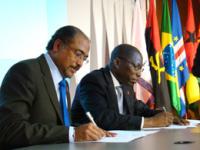
UNAIDS Executive Director, Mr Michel Sidibé and CPLP Executive Secretary, Mr Domingos Simões Pereira signing the cooperation agreement. 17 March 2010, Lisbon, Portugal.
The Community of Portuguese-Speaking Counties (CPLP) and the Joint United Nations Programme on HIV/AIDS (UNAIDS) formalized their cooperation in response to AIDS in CPLP countries with a Memorandum of Understanding. The cooperation agreement was signed today by CPLP Executive Secretary, Mr Domingos Simões Pereira and by UNAIDS Executive Director, Mr Michel Sidibé.
“This agreement strengthens the cooperation that has existed for several years between CPLP and UNAIDS. We are particularly committed to promoting the human rights of people living with HIV and to preventing infection in those countries where Portuguese is the official language,” stated CPLP Executive Secretary, Domingos Simões Pereira.
The Memorandum of Understanding seeks to mobilize technical, political and financial support for civil society networks and organizations, including people living with HIV in the Portuguese-speaking countries. It aims to develop channels for sharing experiences between these countries, by means of horizontal South-South technical cooperation.
“South-South cooperation among Portuguese-speaking nations can help achieve universal access to HIV prevention treatment, care and support and eliminate mother to child transmission of HIV,” said Mr Sidibé. “We can learn from each other, especially when we share a common vision in changing the course of the AIDS epidemic.”
The cooperation agreement forms part of the activities of the III CPLP Congress on HIV/AIDS and Sexually Transmitted Diseases, which is being held in Lisbon, Portugal from March 17-19.
CPLP and UNAIDS sign cooperation agreement in res
Press centre:
Download the printable version (pdf, 44 Kb)
Multimedia:
Contact:
António Ilharco CPLP Portugal tel. +351 21 392 85 60 imprensa@cplp.org
Saya Oka UNAIDS Geneva tel. +41 22 791 1697 okas@unaids.org
Pedro Chequer UNAIDS Brazil tel. +55 61 3038 9220 chequerp@unaids.org
External links:
Community of Portuguese-Speaking Counties (CPLP)
III CPLP Congress on HIV/AIDS and Sexually Transmitted Diseases (CPLP)

